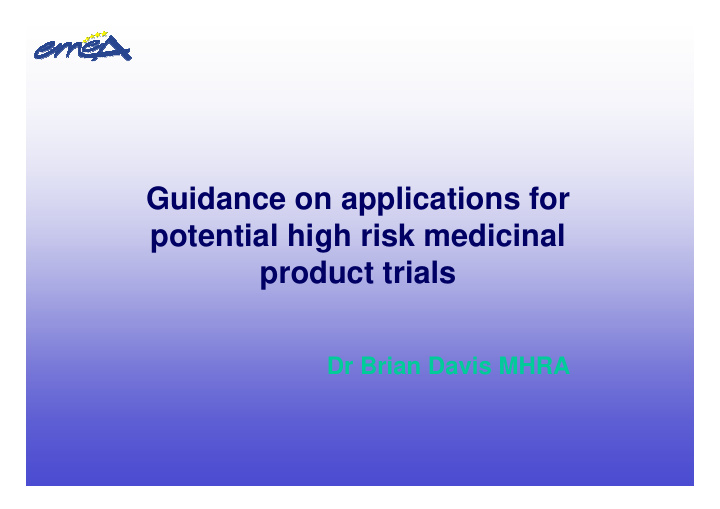



Guidance on applications for potential high risk medicinal product trials Dr Brian Davis MHRA
Overview � Current guidance on commencing and conducting clinical trials; � Issues for high risk medicinal product (HRMP) trials: � Clinical trial site and facilities. � Choice of subjects; � Management of adverse events;
INSPECTORS WORKING PARTY QUALITY WORKING EMEA PARTY CHMP SAFETY WORKING PARTY CLINICAL TRIALS EXPERT EC COMMISSION PHV WORKING WORKING PARTY . GROUP CLINICAL TRIAL Commission Directives FACILITATION Guidelines GROUP Q&A Document HEADS OF Volume 10 Rules etc . AGENCIES
TRIAL MASTER FILE QUESTIONS & RECOMMEND- INSPECTIONS ANSWERS ATIONS GCP GUIDELINE APP. TO CA VOLUME 10 APP.TO EC EUDRACT CLINICAL TRIALS GUIDELINES EUDRAVIGILANCE DIRECTIVES DIRECTIVE PHARMACOVIGLANCE MANUFACTURING AUTH . GMP DIRECTIVE GMP & ANNEX 13 QUALITY ASPECTS OF IMPD GCP DIRECTIVE
High Risk Medicinal Product (HRMP) Trials
Protocol and Application • Protocol should take into account : � All available preclinical data; � All identified risk factors; and � Provide specific risk management strategy.
Protocol and application should discuss: Site of the clinical trial including its clinical environment : � One research centre v several locations; � Availability of data from all treated volunteer(s); � Information system that will provide immediate access to information; � Staff – their level of training and expertise; � Qualifications and skills of the person(s) or the body (e.g. IDSMB) responsible for stopping trial; � Immediate access to facilities for emergency treatment; � Ready access to ITU.
Comments on trial site � Single site – exception for patient studies; � Information communication system; described; � Standards for level of staff training and updating; e.g. experience in early clinical drug development; training in Good Clinical Practice, safety training and basic life support; � MoU with ITU on responsibilities; � Assessment by criteria or accreditation.
Protocol and application should discuss: � Choice of subjects : � Patients or healthy subjects; � High risk potential from the IMP; and � Possible long-term risks.
Protocol and application should discuss: Management of adverse events: � Parameters used to evaluate tolerance and/or pharmacological activity, based on non-clinical data; � Procedures for monitoring and caring for volunteers: � during their stay in the research centre (including stopping rules and any emergency); and � during the ambulatory period if applicable; � Emergency treatment strategy when required; � Provision of supportive treatment; � Rapid access to urgent treatment; � Availability of specific antidotes where they exist.
Comments on managing ADEs � Demonstrable PD effect persisting beyond the duration of the trial; � Communicate to trial participants; Use patients; � Duration of monitoring based on PK/PD data; � Rapid access to treatment allocation codes; � Clarify ‘immediate access’ to ITU facilities; � Issue a pass to participants; Contact plan for participants; � Follow up for potential long-term effects, especially immune-modulators; too vague.
Conclusion � Guidance is available on commencing and conducting clinical trials in the EU; � No current guidance on HRMP trials; � Need to provide guidance on: � Clinical trial site and facilities; � Choice of participants; � Management of ADEs.
Recommend
More recommend